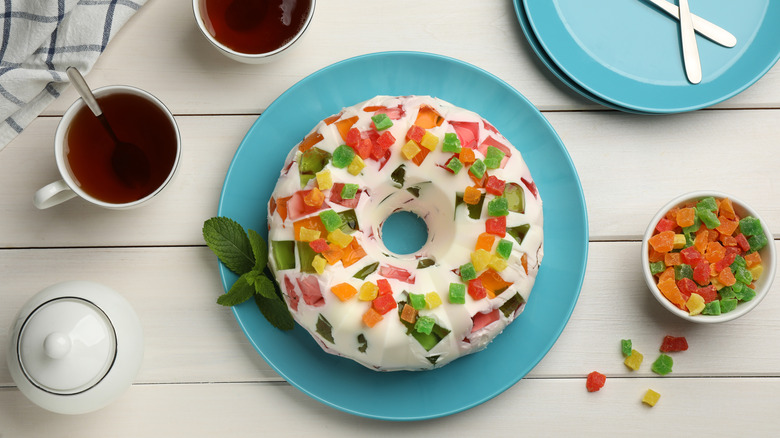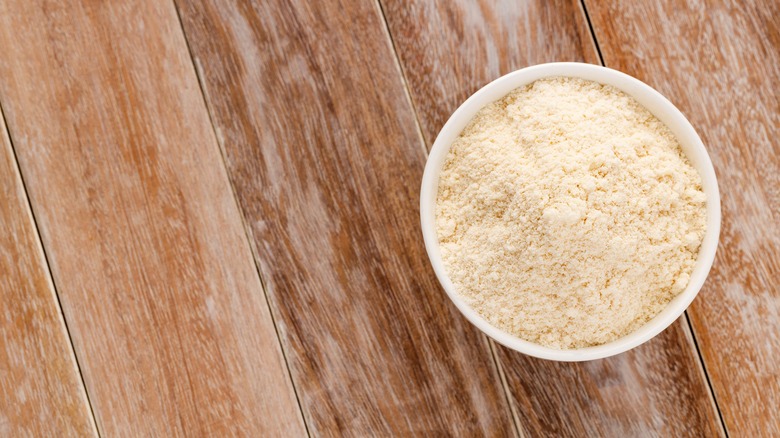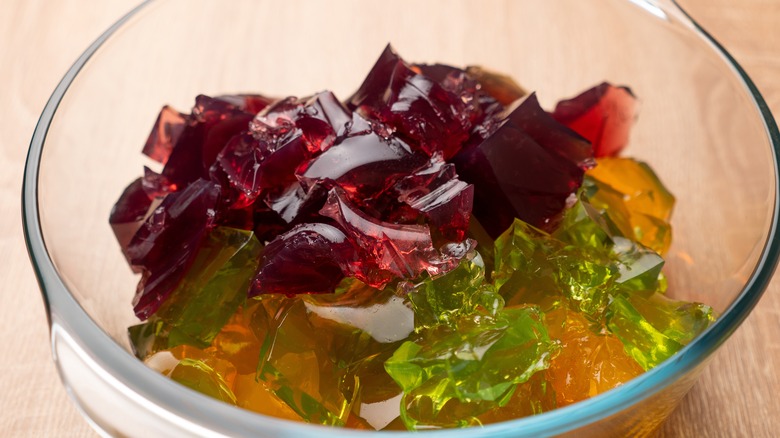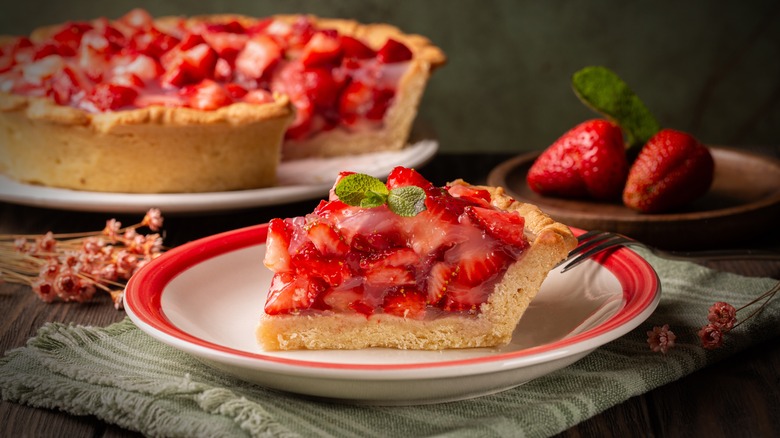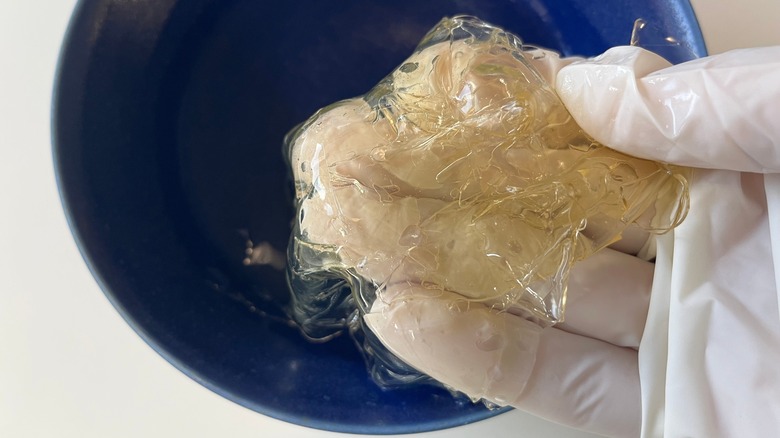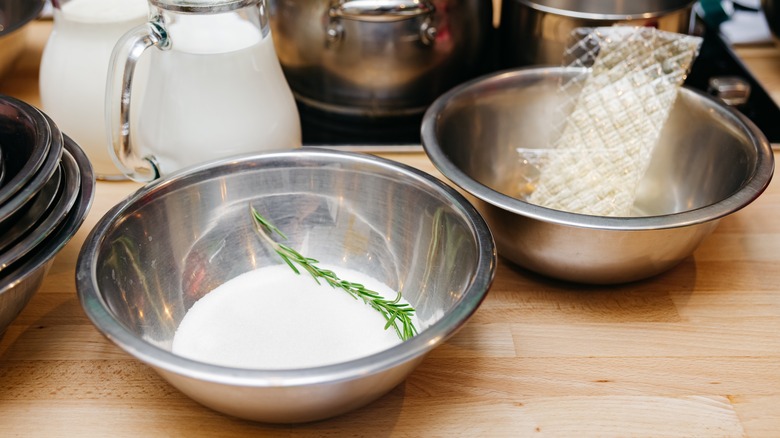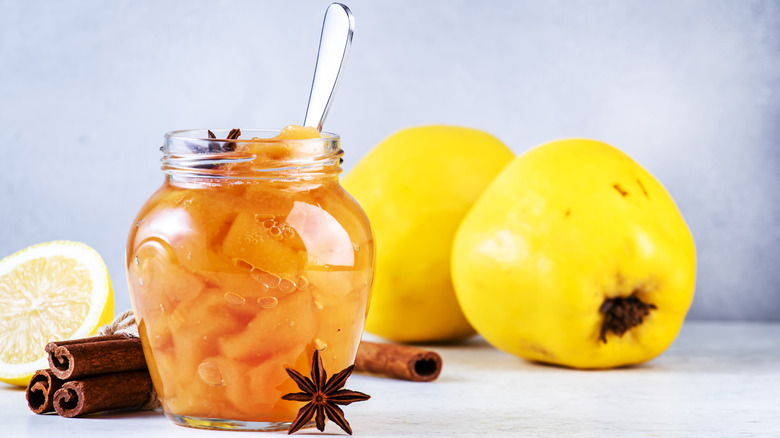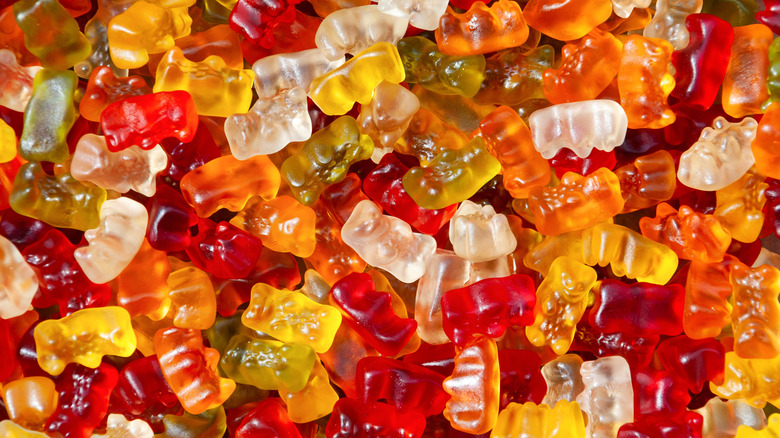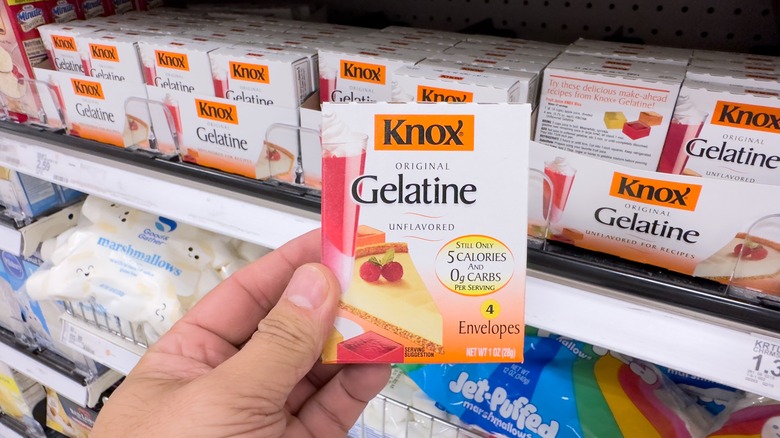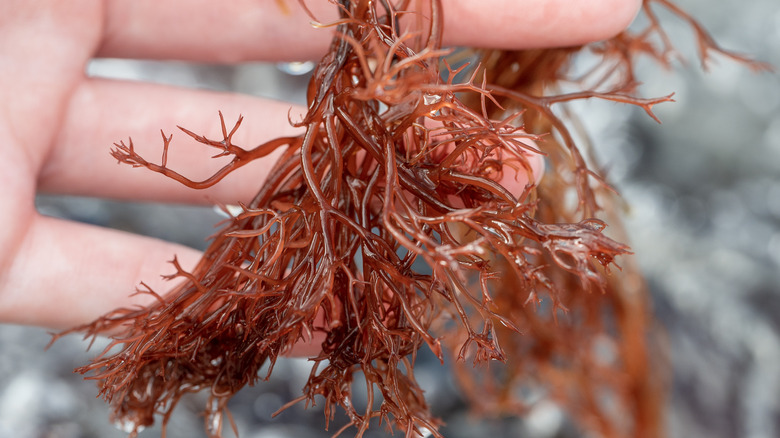What In The World Is Gelatin?
For most of us, the first thing that comes to mind when we think of gelatin is Jell-O, the brightly colored soft dessert with super artificial fruity flavors. Some of us haven't consumed any Jell-O since we were children, so we may think our gelatin days are behind us. But gelatin and Jell-O are not the same thing. Jell-O is just one food that uses gelatin, and gelatin is actually a highly versatile ingredient that pops up in many sweet and savory dishes. From marshmallows to bone broth, you've probably consumed more than you think. And if you haven't eaten any recently, there's a chance that you may have used it on your face or hair in the form of a cream or conditioner.
Always the supporting ingredient and never the star, gelatin hides in plain sight. Its colorless, flavorless presence has almost nothing to do with taste and everything to do with texture and sometimes, nutrients. But what is it exactly, and why is it worth keeping some in your pantry or cabinet?
What is gelatin?
Gelatin is a water soluble hydrocolloid derived from the skin, cartilage, or bones of animals. It comes from the collagen in these animals, contains protein, and is a natural byproduct of cooking meat. Commercially manufactured gelatin is a clear or powdery substance used as a stabilizing, thickening, and gelling agent in many foods. Gelatin also pops up as an ingredient in some pharmaceutical and cosmetic products.
Adding gelatin to all manner of sweet and savory dishes used to be all the rage. Many vintage recipes, including ones from the 1950s, feature foods suspended in gelatin. You may have heard of aspic, which is different from Jell-O, and be haunted by visions of a whole salmon and hard boiled eggs floating in clear jelly. These recipes, like tomato aspic and Jell-O salad, have largely gone out of fashion, but gelatin is still very present in our foods today. Furthermore, some 1950s dishes might be making a comeback. Gelatin can be naturally occurring, such as when you roast meat – the collagen breaks down and turns into a liquid gelatin that becomes a jelly when cooled; other times it's added into a dish.
How is gelatin made?
Gelatin is made from boiling animal skin, tendon, hide, cartilage, or bones. Most commercial gelatin is derived from beef and pork hide and bones, but can generally come from any animal. You may have stumbled across marine collagen in the supplement aisle as a powder or capsule. As a derivative of collagen, gelatin can also be produced from the bones and skins of fish. It's often made from parts of animals that may not have been used otherwise, prompting some advocates call it a sustainable product. And since it's made from natural ingredients, gelatin is not classed as an additive either.
Natural or not, if you don't like the sound of boiled hides and bones, you might be wondering if you can leave gelatin out of a recipe. But gelatin performs an essential function in creating the texture of a dish and holding shapes together. Just try your hand at a layered mousse cake without it and see what happens. The ensuing gooey mess will make you rethink your aversion, or go looking for the best vegan alternative.
What does gelatin taste like?
Now that you know what gelatin is made of, you might be worried that it tastes meaty, fatty, or unappetizing. But fear not, for your strawberry pie won't taste like beef. When you spoon up a bit of gel from your cold chicken the day after a roast dinner, it will have a powerful meaty flavor. But gelatin in its commercial forms doesn't taste like much of anything. That's what makes it such an excellent ingredient in other dishes, like desserts and candies.
For commercial gelatin to be produced (and become flavorless) the animal material is first processed and washed, then boiled, and then the resulting gelatin is filtered out from any other byproducts and dried. The resulting gelatin is almost entirely colorless, flavorless, and odorless. Gelatin works to stabilize the texture of your dish without altering the flavor profile much, if at all. It has no meaty smell or flavor, perfect for adding to chocolate mousse and other sweet dishes. It also won't make bright fruity flavors cloudy or gray.
How to cook with gelatin
Gelatin is largely used to set foods and give them a firmer texture or structural stability. If you're making your own marshmallows, panna cotta, no-bake cheesecake, or mousse, you'll likely need some gelatin. Gelatin dissolves in water, absorbs liquid and then solidifies. If you've ever made Jell-O, you may recall dissolving the sugary gelatin packet in liquid before pouring it into a mold and letting it set in the fridge to produce that firm yet delightful treat.
What if you're stirring some into another batter or thicker substance? Start by blooming the gelatin first. Otherwise, it may clump together and won't mix properly. Place your sheets or powdered gelatin in a little cold water before integrating it into the rest of the ingredients. Place it in a bowl and wait a few minutes. You'll see it start to soften and absorb some of the liquid. The gelatin needs to be added to warm liquid at this point, so if the rest of your batter is not warm enough, then heat the gelatin over low heat first.
If you use too much gelatin, your dish might be a bit tough. But if you use too little, it will fall apart. Have you ever watched a contestant on "The Great British Bake Off" unmold a layered dessert only to burst into tears as it turns into a big mess? Most likely, they didn't add enough gelatin to maintain structural integrity.
Powdered gelatin vs. sheet gelatin
You will find gelatin sold for household use in both powdered and sheet forms. Sheet gelatin are hard little translucent squares that relax and soften when bloomed. Powdered gelatin is what you find mixed in with flavor crystals in a box of Jell-O. It's often sold in small packets, and recipes may call for it in packet units. Powdered gelatin is a great, easy option for setting desserts like panna cotta.
There are few differences between powdered and sheet gelatin — they're essentially the same ingredient, just in a different form. But it can be a little tricky to work out the equivalencies in measurement and adapt a recipe to use one instead of the other. The strength of different commercially sold gelatins can be different from one another, so you can't simply rely on weight to make the conversion. It's recommended that you use whichever option your recipe calls for.
Another thing to keep in mind when working with sheet gelatin is that the blooming process has an extra step. After the sheets have softened for five to ten minutes in a bowl of cold water, you'll want to drain off any excess water before adding them to your recipe. You can do this by simply pouring off any leftover water and gently squeezing or wringing out the gelatin sheets.
Gelatin vs. pectin
Pectin is a thickening and gelling agent derived from plants and is most commonly used to make preserves or maintain the texture of commercial yogurts. Both gelatin and pectin are naturally derived ingredients but while they perform similar functions, pectin and gelatin are constitutionally and nutritionally opposite. Pectin is made from fruits and vegetables and is considered a fiber (some pectin mixes also contain added sugar) while gelatin, a protein, comes from animals. Pectin is vegetarian and vegan, while gelatin is not.
Pectin works best if you're making a homemade jams or jelly. It is sold in both powdered and liquid forms, and works as a preservative to help preserve flavor as well as shelf life. While it does gel and firm things up a lot, it may not set in the same way as gelatin, so it likely isn't a great replacement in most recipes. Overall, these two ingredients are not interchangeable.
What products contain gelatin?
Many foods contain gelatin, and given that it's made from animal products, it may surprise you how often gelatin appears as an ingredient in sweet treats. Did you know that marshmallows are made with gelatin? Many candies like Gummi Bears and some fruit snacks contain gelatin, which is how they get their chewy texture. If you want to avoid animal products, take the time to read labels to figure out which candies are vegan. But if you're okay with consuming gelatin, you could try making your own mango gummies.
Gelatin is often used to make sweet as well as savory mousses, such as chocolate, raspberry, salmon or avocado mousse. It will probably surprise you less to find gelatin in savory foods, like bone broth and canned meats, where its presence is quite intuitive. But people are often surprised when they think they're snagging a little sugar fix to find gelatin among the ingredients. In 2023, The Washington Post reported reported a scandal involving Rocky Road ice cream and the beef gelatin contained therein. Some customers didn't realize that they were consuming beef when they grabbed a scoop of their favorite flavor and felt misled.
Gelatin also appears in non-food products. Gel capsules are usually made from gelatin. The pharmaceutical industry uses these to contain medications like ibuprofen. The cosmetics industry also uses gelatin and many skincare and haircare products contain gelatin to boost their beneficial properties as well as maintain texture.
Is gelatin good for you?
The short answer is yes. Gelatin may sound strange, but most research indicates that it's not only natural to consume, as it is a source of protein, but has many potential health benefits. Meta analysis of studies have shown that hydrolyzed collagen can have a positive effect on skin aging. Other research indicates that gelatin could be good for brain function, bone health, and that the amino acids found in gelatin can promote healthy digestion.
Gelatin and collagen supplements are also consumed to support bone, hair, and skin health in the form of dietary supplements. You can find them in capsules or powdered forms in most health food stores and pharmacies. The two are very similar and purport to help with most of the same things, though they're not exactly the same. But there's still a debate on how well these supplements actually work. While they are equally digestible, collagen powder will likely maintain a more liquid texture when dissolved and therefore be more pleasant to drink in water or a shake. Gelatin can be more comfortably consumed in the form of warm bone broth.
Where to buy gelatin
If you're looking to buy some powdered or sheet gelatin, you'll likely find them in the baking aisle at your grocery store. Knox is probably the most widely known brand, but there are many others. If you're having trouble finding it on the shelves, then you can easily order some on Amazon.
As a supplement, you might find gelatin near the collagen with vitamins and protein powders. If you're interested in consuming gelatin in the form of bone broth, lots of health food stores now sell bone broth. While the name is a bit silly (given that bone broth is actually a stock), the bone broth craze has something to it. A proper bone broth contains lots of nutrients including gelatin and calcium. Many bone broths are actually quite expensive. You can grab some if that's in your price point, or you can make a large batch for yourself at home instead. Next time you have a leftover chicken carcass or other bones from roasted meat, boil them down for hours. You can even ask your butcher for some spare bones, then roast and boil them to make your own bone broth. It takes a lot of time, but not a lot of effort.
Vegetarian and vegan alternatives to gelatin
Gelatin is a low key ingredient, but it may not be enough to sway some vegans. Furthermore, knowing gelatin comes from animal products might even make a vegetarian think twice about their next dish. Fortunately, there are several vegan alternatives to gelatin on the market. The increased demand for vegan products has made it more likely that you'll come across a ready-made vegetarian marshmallow or gummy candy at your grocery store. Just make sure to check the label.
You might be able to use cornstarch or tapioca to solve your baking woes. For tougher jobs, Agar is a common gelatin substitute derived from seaweed. It has commonly been used in Asian cuisine for centuries, but recently picked up popularity as a vegan alternative to gelatin in Western cooking. Carrageenan is another common vegan gelling agent derived from a seaweed called Irish Moss. It's listed as an ingredient in many food products, but it has come under controversy as some researchers believe that carrageenan is actually inflammatory and the culprit to a variety of digestive issues, including irritable bowel syndrome. Other scientists have detailed the reasons that this evidence is flawed and misleading, concluding that there is no valid reason to ban its use.
